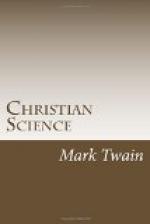There is a most unusual feature about that dispute: the nine persons who decided alike, quoted not a single authority in support of their position. I do not know when I have seen trained disputants do the like of that before. The nine merely furnished their own opinions, founded upon—nothing at all. In the other dispute ("Did Jesus anywhere claim to be God?”) the same kind of men—trained and learned clergymen—backed up their arguments with chapter and verse. On both sides. Plenty of verses. Were no reinforcing verses to be found in the present case? It looks that way.
The opinion of the nine seems strange to me, for it is unsupported by authority, while there was at least constructive authority for the opposite view.
It is hair-splitting differences of opinion over disputed text-meanings that have divided into many sects a once united Church. One may infer from some of the names in the following list that some of the differences are very slight—so slight as to be not distinctly important, perhaps —yet they have moved groups to withdraw from communions to which they belonged and set up a sect of their own. The list—accompanied by various Church statistics for 1902, compiled by Rev. Dr. H. K. Carroll—was published, January 8, 1903, in the New York Christian Advocate:
Adventists (6 bodies), Baptists (13 bodies), Brethren (Plymouth) (4 bodies), Brethren (River) (3 bodies), Catholics (8 bodies), Catholic Apostolic, Christadelphians, Christian Connection, Christian Catholics, Christian Missionary Association, Christian Scientists, Church of God (Wine-brennarian), Church of the New Jerusalem, Congregationalists, Disciples of Christ, Dunkards (4 bodies), Evangelical (2 bodies), Friends (4 bodies), Friends of the Temple, German Evangelical Protestant, German Evangelical Synod, Independent congregations, Jews (2 bodies), Latter-day Saints (2 bodies), Lutherans (22 bodies), Mennonites (12 bodies), Methodists (17 bodies), Moravians, Presbyterians (12 bodies), Protestant Episcopal (2 bodies), Reformed (3 bodies), Schwenkfeldians, Social Brethren, Spiritualists, Swedish Evangelical Miss. Covenant (Waldenstromians), Unitarians, United Brethren (2 bodies), Universalists,
Total of sects and splits—139.
In the present month (February), Mr. E. I. Lindh, A..M., has communicated to the Boston Transcript a hopeful article on the solution of the problem of the “divided church.” Divided is not too violent a term. Subdivided could have been permitted if he had thought of it. He came near thinking of it, for he mentions some of the subdivisions himself: “the 12 kinds of Presbyterians, the 17 kinds of Methodists, the 13 kinds of Baptists, etc.” He overlooked the 12 kinds of Mennonites and the 22 kinds of Lutherans, but they are in Rev. Mr. Carroll’s list. Altogether, 76 splits under 5 flags. The Literary Digest (February 14th) is pleased with Mr. Lindh’s optimistic article, and also with the signs of the times, and perceives that “the idea of Church unity is in the air.”




